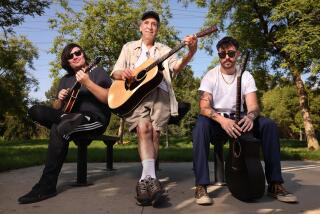Two Girls From Different Worlds Find Friendship
- Share via
William Shakespeare once wrote, “A rose by any other name . . . ,” to refer to similarities between people, yet this aphorism is rarely applied to countries--especially when the countries are the United States and the Soviet Union.
However, 15 Soviet teen-agers spent the week of Dec. 21-27 in Orange County through International Youth Ambassadors of America, a student-exchange organization based in Bellingham, Wash. The students, whose trip was planned and paid for by the Church of Religious Science in Huntington Beach, were on a mission of peace and good will between countries.
Each Soviet youth was paired with a U.S. teen-ager for the seven-day visit. During their stay, they had lunch aboard the Queen Mary, saw the “Glory of Christmas” at the Crystal Cathedral, went shopping at South Coast Plaza, visited Disneyland and spent the Christmas holiday with newfound friends.
On their first day in the county, they also met the press at a briefing at the Church of Religious Science in Huntington Beach.
I was excited to be there as a reporter. Here was my chance to talk to a real live Soviet citizen. Here was my chance to dispel all the preconceptions that I’d been brought up with. Here was my chance to prove that Soviet citizens enjoy some of the same freedoms we do, my chance to create a better understanding between the peoples of the two nations.
So there I stood in the media room after the formal press conference, wondering which of the Soviet students I would be paired with for the afternoon.
As I watched the Soviet students interact with their U.S. counterparts, it seemed to me that the Soviets were younger. Not only did they look younger than the Americans their same age, they seemed to act younger as well.
One Soviet girl, after being paired with a male reporter, whispered to her American friend that she would feel more comfortable with a female reporter. The American then faced the reporter and remedied the situation. Two other Soviet girls huddled by the wall, refusing to be separated for the interviews.
I was paired with Irene Solodova, a 16-year-old blonde from Moscow. She was to be my key to the understanding and insight that I was sure awaited me. We piled into a car and headed for Ruby’s Restaurant on the Seal Beach Pier. Kay McNamar, an 18-year-old from Huntington Beach whose family is very much involved with the “Bridge of Peace” program, accompanied us.
We had traveled less than a mile when my dreams of meeting a typical Soviet teen-ager were shattered. Irene told us she had been to the United States before, 10 years ago and to New York. She added that she had lived in New York for five years. For five years--almost a third of this girl’s life--she was practically American.
Still, I remembered moving from the East Coast and my own wonder at seeing California for the first time.
But if Irene felt any wonder, she sure did a good job of keeping it to herself. She didn’t seem to find the surfers too interesting, nor the offshore oil wells. She had eaten hamburgers before, though explaining the difference between American and Swiss cheese was a new experience for me. In fact, the only time she seemed amazed at anything American was when, after seeing a Christmas decoration, she said, “It’s so strange to see their Christmas trees without snow.”
By this time, I was beginning to get really worried. Maybe I had been misinformed all my life. Maybe all of the Soviet Union looked like the Seal Beach Pier. So I asked about the differences between the two countries.
Irene replied, “Moscow is much colder--below zero.”
By now I was envisioning Moscow as Seal Beach Pier with snow.
Irene reassured me. “There are not major differences. We are not so outlandish though,” she said, with an apparently disapproving wave of her hand at the ‘50s paraphernalia hanging from the walls at Ruby’s.
I was stunned. Maybe the people in Moscow really were typical Communists. Maybe material goods really did mean nothing to them. They certainly weren’t impressing Irene.
But she did say that the jeans she was wearing were bought on her father’s last trip to New York.
Now I was getting somewhere. What other American things did Soviet teen-agers like? Well, though Irene didn’t care for American rock music, she said other youths do, and they like volleyball in the summer and ice skating and skiing in the winter. Their drinking age is 21. However, there is one aspect of Soviet life that American children would find difficult to accept: a six-day school week.
McNamar also seemed impressed by the similarities. “It’s amazing how similar our countries are, yet neither one will let the other have peace,” she said.
Irene added, “I thought California would be not so friendly. Now I see we can find not only enemies but real friends.”
Friends--how simple. Why hadn’t I thought of that? Maybe all Soviets aren’t unhappy living the way they do in the Soviet Union. Maybe not every Soviet is dying to defect, as the media has often led me to believe. Maybe peaceful coexistence can exist.
Our conversation that afternoon definitely proved that the grass isn’t always greener.
Irene wouldn’t trade countries with me, and I wouldn’t trade with her. Yet, as she said, it is possible for us to become friends through understanding our differences.
More to Read
Sign up for Essential California
The most important California stories and recommendations in your inbox every morning.
You may occasionally receive promotional content from the Los Angeles Times.













